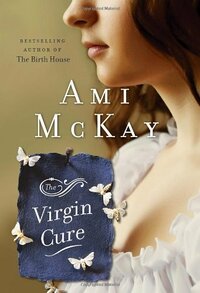Take a photo of a barcode or cover
Good for those who like historical fiction, populated with strong female characters. Set in 1870s New York.
I started reading this and realized partway through that it was written by the same author as [b:The Birth House|171102|The Birth House|Ami McKay|http://photo.goodreads.com/books/1172385530s/171102.jpg|2307275] (which I loved). I really liked this book, though it wasn't quite a 5-star book for me. The characters were all well-developed and the plot was interesting...overall a really great read!
I truly enjoyed this novel. In many ways the novel broke my heart, but it is a narrative that will stick with me.
Moth is just twelve when her mother sells her as a servant to a wealthy socialite. The young girl is convinced it's what's best for both of them even when it means braving abuse at the hands of her new mistress. Moth is soon saved but her mother is nowhere to be found. Now on her own, Moth must brave the streets of New York City and find her own way in the world.
Sorry for the short synopsis this morning, folks - first, I simply don't want to give too much away. Moth's story is an enchanting one and I wouldn't want to spoil anyone's enjoyment (why should I have all the fun?). Second, things are crazypants here thanks to a brief weekend vacation!
I'd set THE VIRGIN CURE on par with last week's reads by Kate Kerrigan - they're historical fiction set in New York (though two different time periods) and they both feature headstrong and resourceful lead characters. Moth is a fabulous narrator - a clever twelve year old living through some tough situations - and McKay has brought her to life glowingly.
One thing I particularly enjoyed were the inset anecdotes and factoids from "Dr. Sadie." They vary as to content and there are extra "articles" dispersed throughout the book as well. They all help set the tone for the time and place - late 19th century New York City.
Now, you may think based on the description that THE VIRGIN CURE might not be the best relaxing summer time read. Normally I might agree except for the fact that having read McKay's latest, I can attest to it being a super enthralling and surprisingly easy read. I actually gobbled up over half the book in just one sitting! So if you're craving a great historical fiction read with a strong female lead, I definitely recommend THE VIRGIN CURE!
Sorry for the short synopsis this morning, folks - first, I simply don't want to give too much away. Moth's story is an enchanting one and I wouldn't want to spoil anyone's enjoyment (why should I have all the fun?). Second, things are crazypants here thanks to a brief weekend vacation!
I'd set THE VIRGIN CURE on par with last week's reads by Kate Kerrigan - they're historical fiction set in New York (though two different time periods) and they both feature headstrong and resourceful lead characters. Moth is a fabulous narrator - a clever twelve year old living through some tough situations - and McKay has brought her to life glowingly.
One thing I particularly enjoyed were the inset anecdotes and factoids from "Dr. Sadie." They vary as to content and there are extra "articles" dispersed throughout the book as well. They all help set the tone for the time and place - late 19th century New York City.
Now, you may think based on the description that THE VIRGIN CURE might not be the best relaxing summer time read. Normally I might agree except for the fact that having read McKay's latest, I can attest to it being a super enthralling and surprisingly easy read. I actually gobbled up over half the book in just one sitting! So if you're craving a great historical fiction read with a strong female lead, I definitely recommend THE VIRGIN CURE!
Easy to read, but light as air, with rather flat characters (other than the protagonist, to a point) and a wispy plot. Also a bit of a strange cross between social expose and something a little more voyeuristic. The ending was particularly unconvincing. Not like I didn't turn the pages, but...
I was really looking forward to this novel - as I adored the Birth House. This novel unfortunately was hit and miss. Great character development, however I felt the story line was a bit shaky. The main character Moth has more than her share of obstacles to overcome. The novel did not keep my attention, and the ending was unrealistic. I did enjoy the way in which newspaper articles and Dr. Sadie's comments were intertwined within the book's chapters.
I did not enjoy this book as much as I had hoped, since I had already read "The Witches of New York", which I absolutely loved. It was nice to get some context regarding some of the characters in both books.
I enjoyed the style of this book, and I thought that all of the stories tied themselves together well. It felt scattered for a while but I liked it in the end. It was a nice mixture of a bit of everything (circus, medical, prostitution, gypsies, stealing...you name it this book probably has it).
This book was better than I thought it would be. I do wish that we found out how some of the minor characters from the book turned out so I think there are some hanging plots that weren’t resolved but I still enjoyed the book.
Despite the title and the premise, this isn't a 'sexy' book, and it's not a historical romance. It's a delightfully real, horrifyingly evocative look at 19th century New York City of the poor -- and one girl's experience with a brothel that specializes in virgins.
(I snarfed this book down during a work conference, and struggled with this review during my post-conference cold, so I apologize now for not properly conveying the delightful awesomeness of McKay's novel.)
The story is told by Moth, in her voice, annotated by Dr. Sadie, a physician of means inspired by the work Dr. Elizabeth Blackwell, who offers care to prostitutes in the Bowery. Moth, a twelve-year old girl, is sold by her mother as a servant to a cruel, rich Manhattanite -- and when she can't stand that life another moment, she flees, deciding life as cared-for prostitute might be better. It is there, at the 'Infant School', where she meets Dr. Sadie, and she learns what power and fortune she can claim for herself.
Often a hard-to-stomach story, McKay's writing kept me coming back -- I'd put the book down for work, or sleep, or something else, and literally vibrate with eagerness until I could pick it back up again. Moth felt real -- which made reading her story so discomforting! But I trusted McKay and the arc of the book and in the end, I was deeply satisfied. The conclusion -- hopeful but realistic -- left me able to close the book without feeling too devastated and I'm already missing Moth and Dr. Sadie. (I'd love a novel about Dr. Sadie, who was inspired by McKay's ancestor!)
Even those allergic to historical fiction might enjoy this novel as I found the heart of the story to be Moth's coming unto her own. New York City of the 1870s -- especially Manhattan and the Bowery -- came alive but didn't overshadow Moth or her story. I can't rave enough about the way McKay articulated what could have been a credulity-straining plot and I so enjoyed the unique way she told Moth's story. Titillating enough in premise for summer but with enough heft to keep one engaged, this is one that's going to make my must read for 2012.
(I snarfed this book down during a work conference, and struggled with this review during my post-conference cold, so I apologize now for not properly conveying the delightful awesomeness of McKay's novel.)
The story is told by Moth, in her voice, annotated by Dr. Sadie, a physician of means inspired by the work Dr. Elizabeth Blackwell, who offers care to prostitutes in the Bowery. Moth, a twelve-year old girl, is sold by her mother as a servant to a cruel, rich Manhattanite -- and when she can't stand that life another moment, she flees, deciding life as cared-for prostitute might be better. It is there, at the 'Infant School', where she meets Dr. Sadie, and she learns what power and fortune she can claim for herself.
Often a hard-to-stomach story, McKay's writing kept me coming back -- I'd put the book down for work, or sleep, or something else, and literally vibrate with eagerness until I could pick it back up again. Moth felt real -- which made reading her story so discomforting! But I trusted McKay and the arc of the book and in the end, I was deeply satisfied. The conclusion -- hopeful but realistic -- left me able to close the book without feeling too devastated and I'm already missing Moth and Dr. Sadie. (I'd love a novel about Dr. Sadie, who was inspired by McKay's ancestor!)
Even those allergic to historical fiction might enjoy this novel as I found the heart of the story to be Moth's coming unto her own. New York City of the 1870s -- especially Manhattan and the Bowery -- came alive but didn't overshadow Moth or her story. I can't rave enough about the way McKay articulated what could have been a credulity-straining plot and I so enjoyed the unique way she told Moth's story. Titillating enough in premise for summer but with enough heft to keep one engaged, this is one that's going to make my must read for 2012.






